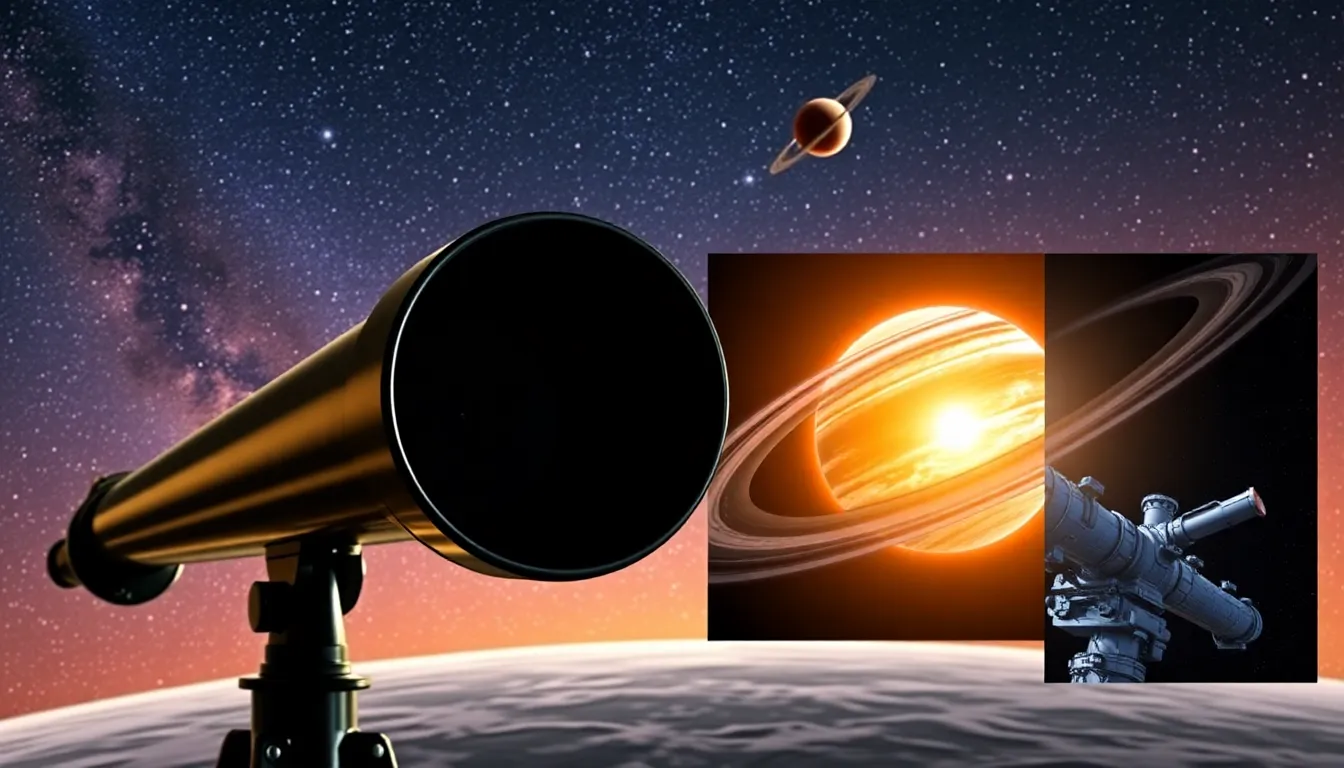In the vast expanse of the universe, the search for exoplanets has ignited curiosity and wonder. These distant worlds orbit stars beyond our solar system, and their discovery has revolutionized our understanding of the cosmos. As technology advances, astronomers are uncovering new exoplanets at an astonishing rate, revealing a diverse array of planetary systems and conditions.
The quest to find these celestial bodies not only fuels scientific inquiry but also raises profound questions about the potential for life beyond Earth. Each new discovery brings with it the possibility of unique environments, climates, and even extraterrestrial ecosystems. As researchers delve deeper into the mysteries of exoplanets, the implications for our own planet and its future become increasingly significant.
Table of Contents
ToggleOverview of Exoplanet Discovery
Exoplanet discovery involves identifying planets beyond the solar system, orbiting other stars. Astronomers deploy various methods to detect these celestial bodies, with notable techniques including the transit method, radial velocity, and direct imaging.
Key Methods of Detection
- Transit Method: The transit method observes temporary dimming of a star’s light when a planet crosses in front of it. This method led to the discovery of thousands of exoplanets.
- Radial Velocity: The radial velocity method measures a star’s wobble due to gravitational interactions with orbiting planets. This approach has confirmed many exoplanets, providing details on their masses.
- Direct Imaging: The direct imaging method captures images of planets by using advanced telescopes that minimize stellar glare. This technique offers insights into exoplanet atmospheres and compositions.
Instruments and Missions
- Kepler Space Telescope: Launched in 2009, the Kepler Space Telescope focused on a small portion of the Milky Way, identifying over 2,600 confirmed exoplanets through the transit method.
- TESS (Transiting Exoplanet Survey Satellite): TESS launched in 2018, surveys bright stars near Earth, expanding the catalog of exoplanets and targeting systems for future studies.
- James Webb Space Telescope: The James Webb Space Telescope, operational since 2021, examines exoplanets’ atmospheres, uncovering the potential for habitability through chemical signatures.
Implications of Discoveries
Exoplanet discoveries enhance understanding of planetary formation and evolution. They also raise questions about the possibility of life beyond Earth. Ongoing studies focus on characterizing exoplanets’ atmospheres, evaluating conditions conducive to life.
Notable Findings
- Hot Jupiters: These gas giants orbit very close to their stars, challenging traditional models of planetary formation.
- Super-Earths: Super-Earths are rocky planets larger than Earth but smaller than gas giants. Their presence suggests a diverse array of planetary types.
- Potentially Habitable Zones: Many exoplanets lie within their stars’ habitable zones, where temperatures might permit liquid water, a crucial ingredient for life.
The ongoing exploration of exoplanets reveals new worlds and reflects humanity’s quest to understand its place in the cosmos.
Historical Milestones in Exoplanet Discovery

Exoplanet discovery progressed significantly since its inception. Key scientists, missions, and discoveries marked this journey, shaping our understanding of the universe.
Key Discoveries
- 1992: The first confirmed detection of exoplanets occurred with the discovery of planets orbiting the pulsar PSR B1257+12, identified by Aleksander Wolszczan and Dale Frail.
- 1995: Michel Mayor and Didier Queloz discovered 51 Pegasi b, the first exoplanet orbiting a sun-like star using radial velocity measurements.
- 2000: The launch of the first dedicated exoplanet search mission, COROT, led to the identification of several exoplanets, further validating detection methods.
- 2009: NASA’s Kepler Space Telescope launched, leading to the discovery of more than 2,600 exoplanets through its advanced transit method, revolutionizing the field.
- 2015: The first measurement of an exoplanet’s atmosphere occurred with the transmission spectrum of the exoplanet WASP-121b, allowing scientists to analyze its composition.
Influential Missions
- Kepler Space Telescope: Launched in 2009, Kepler aimed to find Earth-sized exoplanets in the habitable zone. It discovered over 2,600 planets, expanding knowledge of planetary diversity.
- Transiting Exoplanet Survey Satellite (TESS): Launched in 2018, TESS focuses on identifying exoplanets around the brightest stars, providing data for further exploration and analysis.
- James Webb Space Telescope (JWST): Set to launch in December 2021, JWST enhances atmospheric studies of exoplanets, aiming to identify biosignatures and assess habitability.
- European Space Agency’s CHEOPS: Launched in 2019, CHEOPS delivers detailed assessments of known exoplanets, exploring their size and density to improve understanding of planetary formation.
Methods of Exoplanet Detection
Astronomers employ several methods to detect exoplanets, each leveraging unique techniques to uncover these distant worlds. The three primary methods—transit, radial velocity, and direct imaging—provide significant insights into planetary systems.
Transit Method
The transit method detects exoplanets by observing the dimming of a star’s light as a planet transits in front of it. This method measures changes in brightness, providing estimates of the planet’s size and orbit. When a planet passes between its star and an observer, it causes a characteristic dip in the star’s brightness. This technique has led to the discovery of thousands of exoplanets, especially by missions like Kepler and TESS.
Radial Velocity Method
The radial velocity method measures a star’s wobble induced by the gravitational pull of an orbiting planet. As a planet orbits, its gravitational influence causes the star to move in a small orbit of its own, creating shifts in the star’s spectrum due to the Doppler effect. These shifts can indicate the planet’s mass and orbital characteristics. This method successfully confirmed several exoplanets, including the first detected exoplanet orbiting a sun-like star, 51 Pegasi b.
Direct Imaging
Direct imaging captures images of exoplanets by blocking out the overpowering light of their host stars. This technique uses advanced instruments, such as coronagraphs and starshades, to minimize stellar glare, allowing astronomers to observe planets directly. While challenging, it provides valuable information about planets’ atmospheres and surfaces. Successes in this method include the detection of large gas giants and some Earth-sized planets located within habitable zones.
Significance of Exoplanet Discovery
The discovery of exoplanets carries immense significance for science, influencing various fields of study related to astronomy and astrobiology. It sheds light on planetary systems beyond our own, expanding the known diversity of the universe.
Understanding Planetary Systems
Understanding planetary systems becomes clearer through the discovery of exoplanets. Observations reveal varied structures and compositions within these systems. Findings indicate that planetary systems can possess planets of different sizes, compositions, and orbital arrangements. For instance, the Kepler mission revealed systems with multiple planets, showcasing configurations previously unseen. This diversity challenges previous models of planetary formation and evolution. By studying these systems, scientists gain insights into the processes that govern the formation of planets, stars, and their interactions over time.
Implications for Life Beyond Earth
Implications for life beyond Earth arise directly from exoplanet discoveries. The identification of planets within their stars’ habitable zones suggests potential conditions for life. For example, exoplanets such as Kepler-186f and Proxima Centauri b lie within these zones, where liquid water could exist. Discoveries of diverse atmospheres indicate the possibility of microbial or even complex life forms.
Furthermore, detecting chemical signatures, such as methane or oxygen, in exoplanet atmospheres strengthens the case for habitability. Each discovery propels scientific inquiry into the origins of life and its potential existence elsewhere in the universe. The ongoing research keeps inspiring new technologies and methods for detecting and studying exoplanets, culminating in a deeper understanding of life’s possibilities beyond our solar system.
Future of Exoplanet Discovery
The future of exoplanet discovery looks promising, driven by upcoming missions and technological advancements. These developments aim to expand knowledge about exoplanets and their potential for habitability.
Upcoming Missions
Upcoming missions are set to enhance the search for exoplanets and improve characterization techniques.
- James Webb Space Telescope (JWST): This powerful observatory, launched in December 2021, focuses on analyzing atmospheres of exoplanets. JWST aims to identify chemical signatures indicative of life, enhancing understanding of potential habitability.
- Artemis Program: Targeting lunar exploration, Artemis may pave the way for progressive space missions, enabling robust research and development in exoplanet studies.
- ESA’s ARIEL Mission: Scheduled for launch in 2029, ARIEL will analyze the atmospheres of over 1,000 exoplanets, focusing on understanding their composition and the factors influencing planetary evolution.
- NASA’s HabEx and LUVOIR Missions: Both missions prioritize exoplanet imaging and assessment, especially focusing on Earth-like planets in habitable zones around stars.
These missions promise to propel the field of exoplanet discovery, revealing new insights into the solar systems beyond our own.
Technological Advancements
Technological advancements continue to reshape the methods used for discovering and studying exoplanets.
- Improved Detection Techniques: Enhanced algorithms and machine learning exhibit potential for analyzing vast datasets collected by telescopes, identifying exoplanets with greater precision.
- Next-Generation Telescopes: Development in adaptive optics and coronagraphy leads to sharper images and minimizes the glare from host stars, allowing for direct imaging of smaller exoplanets.
- Spectroscopy Innovations: New spectroscopy techniques enable detailed analysis of exoplanet atmospheres, identifying elements and compounds such as water vapor, carbon dioxide, and methane.
- CubeSats and Small Satellites: Affordable and deployable designs like CubeSats make it feasible to conduct specialized exoplanet missions, broadening access to space exploration and research.
These advancements facilitate unprecedented exploration and address fundamental questions about planetary systems, life potential, and the universe’s complexity.
The journey of exoplanet discovery is just beginning. As technology continues to advance astronomers are poised to uncover even more about these distant worlds. The ongoing research not only enriches our understanding of planetary systems but also fuels the quest for life beyond Earth.
With upcoming missions and innovative detection methods on the horizon the potential for groundbreaking discoveries is immense. Each new finding brings humanity closer to answering profound questions about our place in the universe. The excitement surrounding exoplanets will undoubtedly inspire future generations of scientists and enthusiasts alike.




